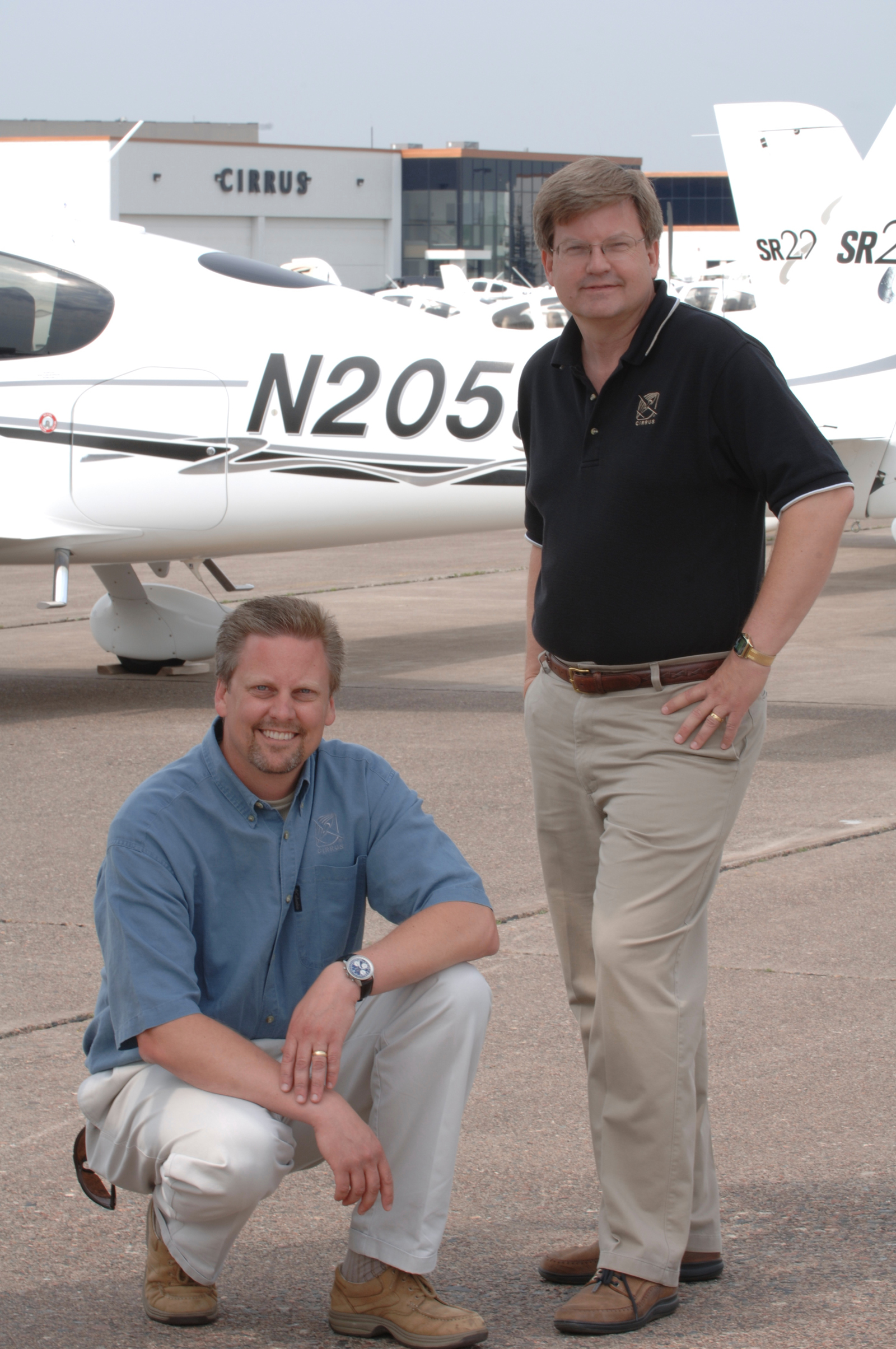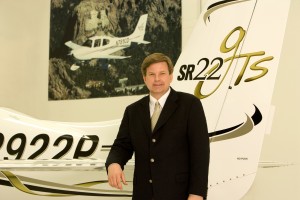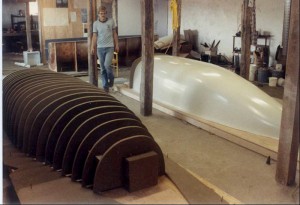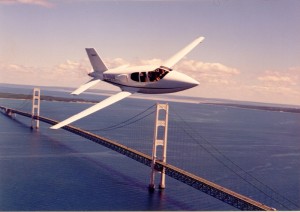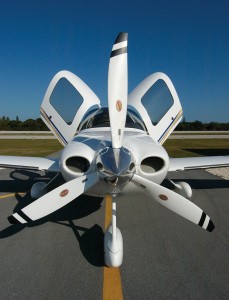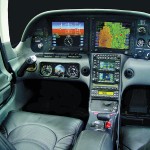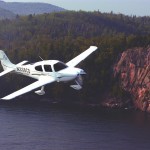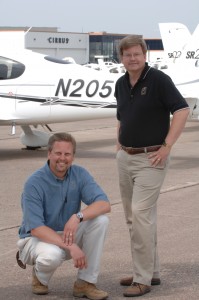
Dale (left) and Alan Klapmeier, in front of Cirrus aircraft parked outside the company’s plant in Duluth, Minn., co-founded Cirrus Design Corporation.
By AJ Staff
For brothers Alan and Dale Klapmeier, their aviation passion has served as the mother of invention.
“You’ll hear us use the phrase, ‘You have to be dumb enough to start and smart enough to finish,'” said Alan Klapmeier, Cirrus Design Corporation chairman and CEO. “That means that if you really knew how things would be, you might not start, and if you weren’t really smart, you wouldn’t be able to finish, once you found out how hard it was. You have to be just naive enough to start to do something you think is right, but smart enough to figure out how to make it work.”
Alan founded Cirrus with his brother, Dale, company vice chairman. After building a Glasair kit aircraft in the early 1980s, the brothers built a kit aircraft of their own design, the VK-30, in their parents’ barn. In 1984, they formed their company. Today, the siblings manufacture FAA-certified, composite, four-place, single-engine piston and turbo-powered aircraft.
When Cirrus Design’s first FAA-certified SR20 airplane appeared on the scene in 1998, it was described as futuristic—a sleek-looking design that had a parachute. No one knew what to make of the aircraft. From the start, Cirrus had designed its aircraft around technology that didn’t yet exist within the general aviation industry. Behind the scenes, for the most part, Cirrus funded the R&D for a glass cockpit, working closely with avionics manufacturer Avidyne. In July 2002, Cirrus announced its all-glass cockpit, which first became available in its second model, the SR22. In 2003, the all-glass cockpit became standard on all its airplanes.
The GA industry has largely adopted the Klapmeiers’ all-glass cockpit design, which captures buyers from around the world. Other manufacturers today are starting to contemplate the idea of installing life-saving parachute recovery systems.
TIME Magazine credited the Klapmeiers with “giving lift to the small-plane industry with an easy-to-fly design.” Forbes Magazine has said Cirrus sells “meaning.”
Today, as one of the world’s largest manufacturers of aircraft in its class, Cirrus is one of the great success stories of modern aviation. What the company has been able to pull off since its first aircraft delivery eight years ago is an incredible feat.
Before the SR20 became certified, few in the industry believed the brothers could design, certify and produce technically advanced aircraft. In fact, many scoffed at their ideas.
For their intense spirit of exploration and sheer devotion to making the GA industry safer and a more interesting and thrilling place for all of us, Airport Journals is proud to honor Alan and Dale Klapmeier as our 2006 Michael A. Chowdry Aviation Entrepreneur of the Year Award recipients.
An inspired childhood
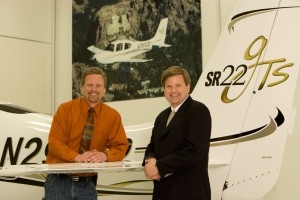
Dale (left) and Alan Klapmeier, in front of Cirrus aircraft parked outside the company’s plant in Duluth, Minn., co-founded Cirrus Design Corporation.
The Klapmeiers may be a long way from their daydreaming childhood, but Alan laughs and says they’re still called “the kids” or the “boys up in Duluth.”
Alan Klapmeier was born in October 1958, to Larry and Carol Klapmeier. Dale joined the family in July 1961. Aviation entered Alan’s life early. His parents often told him that he was a “very needy baby” who cried a lot. His mother came up with a great solution.
“To keep me from crying, Mom would have to hold me or have direct eye contact with me. She’d sit me on top of the kitchen counter, and, while keeping eye contact with me, she’d talk to me while she cooked or did dishes—or I’d be screaming,” he laughed. “Mom also said the only way she could get any peace was to drive out to the airport, park the car and sit at the end of the runway. She’d sit in the car and read a book. I’d watch airplanes and stop crying. My brother, Ernie, who’s 14 months older than me, would play in the grass outside of the car.”
He says he and his younger brother have always been fascinated with airplanes—something ingrained into their souls by their own volition.
“Whatever the toys that kids had in 1959 and 1960, mine would have been airplanes,” he said.
From an early age, the future aircraft designers and manufacturers made airplane models, but at that time, they took the easy route and purchased store-bought kits.
“Ernie built wooden Curtiss Jenny models, which were impressive. At 6, I made the plastic Revell models. Out of the three of us, Ernie made great models, I made average models and Dale broke ’em all,” Alan laughed. “When he was 3, Dale liked to throw things. For Dale it was like, ‘Oh, that’s fun, grab it in the middle and break the model!'”
The boys fantasized about flying the real thing.
“This was during the period right after ‘The Great Waldo Pepper’ came out,” says the model plane destroyer, referencing the 1975 memorable barnstorming movie starring Robert Redford.
Alan rode his bike past the airport, to check out the “cool looking airplanes” that had landed each day. He recalls that as adolescents, he and his younger brother also discovered a passion for racing. In the early 1970s, their parents bought a family vacation farmhouse in North Freedom, Wis., about 10 miles southwest of Baraboo. Now, with enough space, the brothers managed to get some mini bikes.
“Mom and Dad were particularly worried that Dale would be a daredevil, because when we were little, he really pushed for getting a motorcycle,” he said. “As soon as we got mini bikes, we were out racing around the fields. I’m sure their next thought was, ‘Now they’re going to be out racing around in airplanes!'”
Dale says he suspects his parents thought he and his brother would eventually lose interest in their need for speed.
“They bought the mini bikes because they thought I would get it out of my system,” he laughed. “That was part of the reason Alan and I were allowed to get into flying as well. It didn’t work.”
Alan recollects the moment in his life when aviation “really” inspired him.
“I had just turned 15,” he says. “The December 1973 issue of Flying Magazine had a Piper Warrior on the cover. That led me to do a speech in my sophomore class about why general aviation was so good. It was the ‘persuasive argument’ speech we had to give. After reading that article, I started riding my bicycle past the airport more often, as opposed to just building model airplanes.”
He still has that magazine.
“There was also an article on the Skyhawk and the Grumman Traveler,” he fondly recalls. “I have thousands of aviation magazines.”
Dale recalled picking up a copy of Flying Magazine that featured the Bede Aircraft BD-5, a single-place, sporty, high-performance kit plane, introduced in the early 1970s.
“I remember going up to Dad and saying, ‘Let’s build an airplane!’ He looked at me and said, ‘Are you out of your mind?'” he laughed.
His older brother also recalled that day.
“As he was laughing, Dad said, ‘My kids are insane!'” Alan smiled.
While in the high school band, Alan became acquainted with Ernie’s friend, Scott Ellenberger. The two trombone players connected right away. Ellenberger, who was a year older and already had his driver’s license, would drive Alan past the airport.
“We’d drive by the airport just to see if anything different was there,” Alan said. “We hung around talking to people.”
Completely smitten with aviation, Alan joined the Civil Air Patrol while still in high school.
“I was in my junior year,” he explained. “Joining was about me trying to learn how to fly at a younger age, and at a lower cost, too. Somebody at the airport must’ve said, ‘Here’s a way to learn to fly; join the Civil Air Patrol.'”
Alan began taking flying lessons at the beginning of his senior year, while his younger brother began lessons when he was 15. Their father had a 1960 Cessna 182; later, he bought a 1981 C-Skylane 182 RG. When the two brothers decided to buy their own aircraft, Ernie joined them, and together, they bought a 1947 Cessna 140. (Today, Ernie buys and sells old military equipment).
Alan graduated from Ripon College in 1980, with degrees in physics and economics. In December 1983, Dale graduated from the University of Wisconsin Stevens Point, earning a degree in business administration with an emphasis in economics.
Dale says that when he went to college, he didn’t have a clue what he would study.
“The idea was to find something to do with airplanes,” he said. “But, if nothing else, I knew I could be a banker; that was my fallback career. I studied economics and majored in business with a finance emphasis.”
The Champ and Glasair
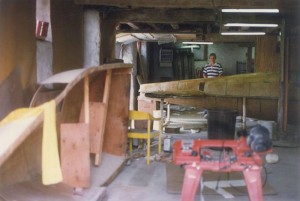
Alan Klapmeier works on the brothers’ kit airplane, a VK-30, in their father’s garage. The two built the airplane more than 25 years ago, while living in their family farmhouse in Wisconsin.
In 1979, the brothers bought a wrecked 1960 Champion 7-GC, which they rebuilt. Dale says that experience really turned him on to building airplanes.
“I was going on a rafting trip in northern Wisconsin,” Dale recalled. “On the way there, we had to stop and look at each airport that we passed, to check out new arrivals. Then, I saw a Champ, sitting upside down; the wind had flipped it over. Alan and I thought that it would be a great moneymaking adventure; we could buy this airplane very, very cheaply.”
They worked on it in a shed at the farm. Larry Klapmeier had just built a garage onto the farmhouse, and his sons had promised not to bring airplane parts into it. However, when the shed was overrun with parts, the brothers moved to the garage.
“Mom and Dad were gone for a couple of weeks. Alan and I planned to use the garage while they were gone, and get out before they got back,” Dale laughed.
They believed they could rebuild the Champ in one summer, but it took two and a half years.
“We didn’t make any money on it,” Dale said. “But, rebuilding that airplane was key to giving us the confidence that we could do it.”
In 1980, during EAA AirVenture Oshkosh, they bought a Glasair kit from Stoddard-Hamilton. The aircraft was a two-place, side-by-side composite taildragger. They took delivery of the plane in 1981. After outgrowing their parents’ shed and garage, they finished the plane in the farm’s barn. The Klapmeiers flew the Glasair in the spring of 1984.
The VK-30
While Alan was still in college, the brothers continued to talk about going into business together.
“We talked about the kind of aircraft and company we would have, perhaps building ultralights or maybe starting a company that built composite airplanes,” he said. “I’m sure that separately, we also wondered, ‘Are we going to get jobs being bankers or do some other kind of business?’ But, from 1979 on, we started thinking about what kind of aviation manufacturing company we would have, from a realistic point of view.”
When they did decide to form their company in 1984, they included Alan’s college roommate, Jeff Viken. That year they had finally flown their Glasair, and had begun working on their own airplane design, the VK-30.
“We had drawings of the VK-30 five years before that,” Dale said.
The VK-30 was a composite pusher, with conventional wings and tail. It would eventually be the first kit aircraft featured on the cover of Aviation Week and Space Technology.
“The VK-30 was a four to five-seat aircraft,” Alan said. “Three people could sit across the backseat. We decided to do a pusher, because we were spending a lot of time thinking about high performance and natural laminar flow. We believed that we could get increased natural laminar flow on the fuselage and higher performance if we didn’t have the propeller out front.”
Dale said they liked the pusher design for a number of reasons.
“Speed was certainly at the top of the list,” he said. “If we put the single biggest airplane part, the engine, in the middle of the airplane, rather than out front, we could get a smaller frontal area with increased laminar flow. Moving the noisy prop and exhaust away from the cabin would make it quieter inside. Also, everything in the cabin brings the center of gravity forward.”
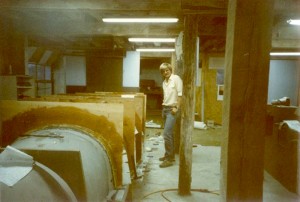
Alan Klapmeier is in the lower level of the farm’s barn, where they began work on their VK-30 in 1984.
“That also meant the airplane had better visibility,” Alan said.
In 1985, they cut the first parts for the VK-30 fuselage.
“We started the VK-30 in the lower level of the barn, down where the cows were,” Alan recalled. “Picture stone walls and a timber-framed ceiling.”
The brothers moved into the farmhouse to be closer to their project. Later, they built a hangar on the farm.
“We didn’t have to pay rent, and the barn became our factory,” Alan laughed. “Those were lean times; we ate a lot of macaroni and cheese.”
The brothers and Viken had formed Cirrus Aircraft Corporation as an exploratory company. In 1987, its successor, Cirrus Design Corporation, was formed in Wisconsin. Viken and his wife, Sally, left the company in 1988.
Dale says that their parents—who were shareholders in the original company—are probably relieved, now that Cirrus is successful.
“I think ‘relieved’ is probably the right word, given how many times we had to go back and ask for money to help cover payroll,” Alan laughed.
Their parents’ generosity didn’t surprise the brothers; everyone in the family had “limitless dreams.”
“It’s always been that way,” Alan says. “Mom and Dad had also gone through starting a business, so they knew how hard it was. They’re glad we’ve survived. I think they felt sorry for us. They were very helpful during horrible, hard times; we had a lot of them. So when Dale says our parents are relieved, they’re relieved that we got here; parents don’t want to see their children suffer.”
These days, their parents are definitely proud of what Alan and Dale have accomplished.
“The company is much bigger and more successful than they expected,” Alan said. “But they wouldn’t say it’s bigger than they ever dreamed. As we would describe what we thought this was going to be, they certainly would have had the same dream that it would work, and that Cirrus would be this big or even bigger.”
Dale smiles when he thinks about his parents’ involvement.
“I’d say they now have more fun at the air shows than we do,” he said. “They like to go and brag, so they have a lot of fun with it. They were extremely supportive. They’ve been there for us all the way through this, from the very beginning, when we said that we were going to build airplanes. They never once said, ‘You can’t do that,’ or ‘It won’t work.'”
Alan doesn’t totally agree with that statement.
“Actually, they did say, ‘It won’t work,'” he corrected. “But they didn’t say, ‘You can’t do it.’ They always told us we wouldn’t starve. They said, ‘You can always move back to the farm,’ and, ‘It’s better to be broke when you’re young!'”
Alan remembers how “Cirrus” found its way into the company name.
“We were driving Dale’s friend’s pickup truck from Dekalb up to the farm,” Alan offered. “I think we were hauling parts for the Champ. Dale would’ve still been in college. We rebuilt part of the wings under the deck down in Illinois, so we were in that pickup truck, driving past Jamesville, on the way to the farm. We had decided Klapmeier Aircraft Company didn’t have the right ring to it; we spent about an hour talking about company names, going back and forth. That’s when Dale suggested ‘Cirrus.'”
Dale has a different recollection.
“My story, right or wrong, is a lot better,” he laughed. “We were driving down from the farm, probably around 1979, to Grandma’s and Grandpa’s, who lived in Chicago. The point is, we were driving, because we couldn’t fly; the weather forecast was for thunderstorms, and VFR wasn’t recommended. The only cloud we saw all day was a Cirrus cloud. Cirrus clouds are what you want to see as a pilot; they’re the fastest fair-weather cloud. We first thought of naming our airplane ‘Cirrus,’ but we agreed at that moment to name our company Cirrus.”
Although it’s long been forgotten who was driving, the brothers agree on one important detail.
“We agree that we were sitting in the truck, wishing we were flying,” Alan said.
Changing the aviation world
In 1994, the brothers moved company headquarters to Duluth, Minn. At the 30,000-square-foot research and development facility, they began work on the SR20, a four-passenger, single-engine, piston-powered, composite aircraft. That same year, Congress also passed the General Aviation Revitalization Act, renewing the single-engine piston market. Cirrus leapt into a new frontier, competing with aviation giants like Cessna.
The first prototype of the Cirrus SR20 made its maiden flight in 1995. The following year, the company broke ground on a 67,500-square-foot manufacturing facility in Grand Forks, N.D. In 1997, Cirrus started assembly of its first production prototype aircraft. In 1998, the company moved into an 111,000-square-foot manufacturing facility, adjacent to its R&D facility and headquarters in Duluth.
In 1999, the same year that Cirrus made its first customer delivery of an SR20, the company began work on the SR22, a four-seat aircraft with a 310-hp engine. Four years later, the company introduced the VFR-only SRV at EAA AirVenture. With a base price of $199,000, the SRV is the company’s lowest priced aircraft.
“It’s more for the recreational flyer or for use as a trainer,” Dale said. “In order to drive the cost down as much as possible, we had to take out as many systems as we could. Costs go up quickly when you add more systems.”
The same year the SRV was introduced, Dale purchased the company’s 1,000th production aircraft—an SR22. The company celebrated its 3,000th production aircraft in November 2006; Alan owns that SR22-GTS.
“It has the same fuselage structure, but different wings and quite a few different internals from the SR20 and the SR22,” Dale said. “The 22 is our top-of-the-line airplane. The 22-GTS has all the options on it.”
That model later underwent a retrofit with a turbocharged engine. The SR22-GTS Turbo, the company’s newest aircraft model, was FAA-certified November 2006, with a supplemental type certificate.
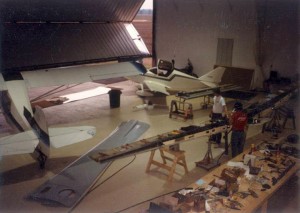
The brothers moved into the family’s farmhouse to be closer to their project. They later built a hangar on the farm.
“It’s our highest performance airplane,” Dale said.
Cirrus manufactures 15 aircraft per week in its 250,000-square-foot manufacturing plant in Duluth. That facility is adjacent to what the Klapmeiers affectionately dubbed the “Moose Works,” a 20,000-square-foot research and development facility. Cirrus also has a 153,000-square-foot facility in Grand Forks, N.D. and additional facilities in Hibbings, Minn. The brothers formed parent company Cirrus Industries Inc. in Delaware in 1996, as an umbrella over all their burgeoning enterprises, and for the first time, they brought in outside investors. Cirrus Industries’ related companies include Dakota Aircraft Corporation, Aileron LLC, Cirrus Finance Company, Cirrus Insurance Agency LLC, the Jet Company and Aerospace Capital Group.
Competition is fierce, but the company’s sales numbers speak for themselves. Cirrus delivered 600 aircraft in 2005 and about 700 in 2006. In 2001, Cirrus captured 11 percent of the market for single-engine piston planes. Today, the company holds a 33-percent share. Even those healthy numbers don’t reflect the aviation market that Alan would like to see.
“In 1978, the industry produced almost 18,000 airplanes,” he observed. “It seemed to fall off a cliff in the late 1980s through the mid-nineties; it produced only about 1,000 airplanes per year. We now believe that the industry is very small compared to what it could and should be. Personal transportation aircraft offer great value for people who want to travel. If we can make it easy enough for them to fly and safe and comfortable enough that they’re willing to fly, our industry should be able to sell thousands of airplanes. We certainly expect to have our share of that. I don’t think a 700-airplane number is a lot. In fact, I would like to see the industry selling 10,000 airplanes per year, instead of 2,500.”
Dale says Cessna is still the “big dog” in the industry.
“Cessna is the one that we’re all chasing, I guess,” he said. “But we don’t look at Cessna as our competitor, except that if somebody buys a 182, they’re not going to turn around and buy an SR22.”
According to Dale, the company’s biggest competitors are the companies competing against the industry for what people do with their money. Cirrus also must compete with companies that offer alternatives to flying.
“Inside our industry, rather than beating each other up, we have to convince the world that general aviation makes sense,” he said. “Every time I’m in the airplane, I’m amazed that the GA industry isn’t 10 times bigger than it is. So, the question is: ‘How can people who travel a lot do it without GA?’ They’re spending huge amounts of time sitting in airports, sitting on the road or sitting in hotel rooms, rather than being productive. They’re not with their families, and they’re not where they want to be. It’s just amazing to me.”
It’s certainly not amazing that the SR22 is one of the most significant contributions to modern aviation. Alan says the overall look of the airplane is modern and practical, but Dale describes it as conservative.
“We designed this airplane while we were building the VK-30, which was very radical,” Dale said. “When we drew pictures of the SR20, we weren’t after something that looked completely different from everything else. We wanted people to look at our airplane and say, ‘That’s a very nice airplane,’ and then go back to their Piper or Mooney and say, ‘All of a sudden, my airplane just got old.’ It’s not a radical look. It was originally designed to be conservative looking, but practical is probably the better word for it.”
With its range of 800 nautical miles, the SR22 is useful for almost any business or leisure traveler, including Alan Klapmeier.
“I’ve flown from a meeting in San Diego to Washington, D.C.,” he said. “I use it coast to coast. It’s the only way I travel. People are finally realizing that they can get out of their car, get into an aircraft like the Cirrus SR22, fly very quickly to their appointment and get back the same day. They can have dinner with their families or get to their next meeting.”
He added that some Cirrus employees own the company’s aircraft, but for those that don’t, he says flying Cirrus planes is easy enough to do.
“We have a Cirrus flying club that has two SR20s; probably 100 or more Cirrus employees fly them,” he said.
SATSair
One of the company’s many partnerships is with start-up SATSair, a FAR Part 135 charter operator that uses Cirrus planes for its new air-taxi service. Cirrus owns 21 percent of SATSair, which eventually hopes to take delivery of 100 Cirrus aircraft. Alan Klapmeier is confident SATSair founder and CEO Steve Hanvey will be able to complete the order for aircraft, as his company attracts more investors over the next 12 months or so.
“They have 25 airplanes, a significant number, but they’re still looking for money,” he said. “Raising money was harder for us than designing, certifying, building or selling our airplanes. By far, raising money is the hardest part for any company.”
Alan said SATSair is growing quite successfully, and customer response has been good.
“Customers are finally leaving their automobiles,” he said. “Instead of driving four, five, six or seven hours, they’d rather fly. So, again, the question is: ‘How do you do regional transportation without an airplane?'”
The company’s investment in SATSair is a demonstration of its belief in the air-taxi concept.
“Somebody has to go out and prove it,” Alan said. “Once somebody is successful, everybody else will find it easier to raise money and demonstrate that they can be successful.”
Technically advanced aircraft
Cirrus led the way for technically advanced aircraft in the GA industry, with its usable primary flight display. Because of these advances, the company’s planes are also used to train professional Part 121 pilots.
“Future airline pilots will learn to fly with what we now call glass cockpits: PFDs and MFDs (multi-function displays),” Alan said. “I think we had a lot to do with making that the standard expectation of how people will learn to fly, rather than some high-end option they’d learn about later in their careers. I think that 100 years from now, people will look back at the primary flight display—the information display in the cockpit—and say it was the single most important change in the industry—the piece of technology that caused the industry to grow again.

This photo of the Klapmeier brothers, taken in Cirrus Design’s infancy, shows a rare sight—Alan Klapmeier sporting a mustache.
“I think this is attributed to Cirrus. It’s something that we’ve been pushing since the early ’90s. We’ve worked with a number of avionics companies, not just those that we use. We worked with the NASA Agate program. Cirrus was the first to install a PFD in an airplane in its class. We were also the first to make it standard. We made it standard on all our airplanes, changing customer expectations. People began wanting it. It’s a huge safety factor.”
The parachute factor
A large part of the company’s reputation for safety comes from the inventive, well-tested Cirrus Airframe Parachute System, manufactured by BRS Inc., based in Minnesota. The Klapmeiers had been exploring ways to make their planes as safe as possible and were enthusiastic about adding a parachute system to their aircraft.
“We had decided to put the parachute on our aircraft before it had ever flown,” Alan said. “It’s not something we decided we needed after flying the airplane.”
BRS was excited about the idea of manufacturing aircraft with a standard parachute deployment system.
“In discussions with BRS, we said, ‘Let’s figure out how to make it work,'” Alan recalled. “The difference between Cirrus and other aircraft companies that had looked at the parachute idea was that those companies said, ‘It’s too complicated, too heavy and too expensive; pilots don’t need it.’ They gave a whole list of excuses why not to do it. We weren’t looking for excuses. We said, ‘Yes!'”
Dale said that when they first started the process to certify the SR20, they explained the airplane’s performance to BRS.
“We explained the weight of the airplane and other details,” Dale said. “From there, it seemed like an easy calculation.”
Testing of the company’s parachute system began in 1997. Today, a 2,500-square-foot overhead parachute is standard on all Cirrus airplanes, but getting there was more complex than what the brothers first anticipated.
“BRS said, ‘We’ll do three drops, the parachute will be certified, and then, we’ll figure out how to put it in the airplane,'” Dale recalled. “We thought the airplane would then be certified. We rented a cargo plane—a C-123—and loaded barrels of sand connected to a parachute into the back of the plane. Pushing the barrels out of the back of the plane would test the limits of the parachute and would show if the parachute was strong enough.”
Dale said the first three drops didn’t go as planned.
“We describe it as ‘bombing the desert with barrels of sand,” he laughed. “The military can push a tank out of the back of an airplane under a parachute, and space capsules come down from outer space with parachutes. But we bombed the desert for a couple of years before we got the system to work. The difference is, to control the load, we needed the parachute to open quickly, with the plane at a slow speed, and to open slowly, with the plane at a high speed.”
He said the parachute had to prove much more.
“It had to be able to open in a spin, straight and level, in a dive and with very little weight or very high weight,” he explained. “This huge range of requirements went into the design, and it became very difficult to meet all of those requirements. We bombed the desert 38 times before we had a canopy that worked and covered the range of requirements.”
After they had a canopy that worked, they then had to figure out how to get it in the airplane.
“And we had to know how to get it out of the airplane,” Alan said.
Dale explained that from the first drawing, the entire airplane was designed around having a parachute in it, down to how strong the engine mount had to be.
“You can’t have a parachute deployment causing the engine mount to fail and the engine to fall off the airplane,” he said. “So, you end up redesigning your engine mount to cover the parachute.”
Dale says their parachute system worked well in that it was designed, from the beginning, so that the empty weight would be equivalent to any other airplane of that size and performance.
“And that’s even with a parachute on board that weighs 50 pounds—the structure and everything else that’s required to put that in the airplane,” he said. “It was all part of the design requirements, right from the beginning. But, we had a huge number of complications, from the straps being buried in the fuselage, to how they tear out. The straps have to be able to tear out without being damaged. After figuring out the structure, the straps’ attach points, the rocket system and the actuation system, we had to do flight testing with it. We did eight in-flight deployments, from being in a spin to pulling the parachute at higher speeds. We tested it to 138 knots.”
It took five months to compete those eight tests. According to Dale, it took four years to perfect the entire process. Alan says that neither he nor Dale were ever in the desert as flight tests were being preformed. They credit the company’s hardworking test pilots and engineers for risking their lives and making it work.
The next aspect was the seat design.
“The seat had to absorb a vertical energy component, different from anything else,” Dale said. “We had to have a 26-G seat requirement on the airplane. The parachute has to protect all the people on board, so you have to design to absorb energy—the belly of the airplane and the seat design.”
The seats underwent testing for two years.
“We did sled tests to develop a seat that would work,” Dale explained. “They had to be lightweight, comfortable and fit in the airplane. We did multiple shots with the seats; we put dummies in an airframe and lifted it and dropped it. We had to measure what all the loads were. We passed our last test a couple of days before getting our certification in October 1998.”
With a laugh, Alan says, “I still maintain it was a good idea. Although it took a long time, we had a can-do-it attitude!”
Alan says some people in the industry believe that less-trained, less-qualified pilots will use CAPS as an excuse, thinking, “If it doesn’t work out, I’ll just pull the chute.”
“That’s absurd,” he said.
When Cirrus certified its SR20 in 1998, the company became the only GA manufacturer in the world to offer a rocket-deployed airframe parachute as a standard feature. In 2002, for the first time in history, a certified aircraft landed via parachute, and the pilot walked away uninjured.
Because the brothers were willing to invest more than $10 million developing CAPS, 21 lives have been saved, involving nine chute pulls. Alan said only one fatality has occurred with a chute pull, when a pilot became incapacitated with three passengers on board. Although the pilot was dying, the pilot’s son was able to pull the chute, saving his life and that of two other passengers.
“Pilot incapacitation demonstrates one of the parachute’s purposes,” Alan said. “Parachute systems have become reasonably well-accepted. We now believe in airbags, when back in the 1950s and early 1960s, people thought they were unnecessary. The parachute is becoming much more accepted, but is still somewhat controversial. We talked about doing this in the early 1990s, and in 1994, we publicly introduced our parachute system at Oshkosh. Some said, ‘I don’t need a parachute, because I’m a good pilot. I’m safe. None of those things would ever happen to me.’ That’s when you say, ‘What if it’s not up to you? What if you have a heart attack and you’re dying? What about your passengers?’ It’s not just for the pilot.”
He also has a personal inspiration for the use of a parachute recovery system. In 1985, he had a midair collision that nearly cost him his life.
“That collision claimed the life of the pilot in the other plane,” he said. “I made a promise that when we manufactured aircraft, we’d have a parachute recovery system; people don’t have to die.”
He had been flying his father’s Cessna 182 RG with his instructor, working on his instrument rating.
“Paul Boehm was piloting the other plane,” Alan said. “I knew him from the next airport over. He was flying a Piper PA 17 Vagabond, a high-wing, fabric airplane. We think he saw us at the last moment and tried to bank out of the way. Our wing went through his strut, folding his wing back. He spun to the ground and was killed on impact. The impact was our right wing to his right strut. If he’d been able to pull a parachute, he’d still be alive. It was very traumatic; it still shakes me up to think about it.”
Although the collision was horrific, Alan said he never considered giving up flying.
“The accident happened on a Friday evening,” he said. “My instructor and I went flying again on Monday, because we decided that we had to get back in the saddle. We were very nervous during the flight, though. Every time we hit a bit of turbulence, we’d look at each other with wide eyes.”
Other incidents have given Alan pause.
“On three occasions, which could’ve been fatal, I would’ve used a parachute if I’d had one,” he said.
Between 1989 and 1992, Alan and Dale frequently discussed having a parachute recovery system.
“Dale’s son was born in 1988, and my daughter was born in 1989, so we were both starting to think more about safety,” Alan said. “That changed both our attitudes. Our earliest thoughts were, ‘It’s all about performance.’ Then, it was, ‘It’s all about ease of operation,’ and finally, ‘How do you make flying safer and easier at the same time?'”
Alan remembers thinking at a young age that flying could be very dangerous.
“With the midair collision, those thoughts again came to my mind,” Alan said. “But I also thought, ‘At least I was doing what I loved.’ Then, when you start having kids, you start thinking, ‘Am I nuts? I’m a father! I’ve got to be around.’ So, you stop thinking that it’s OK if it’s dangerous. You start thinking a lot more about making flying safer. Now, some people would say, ‘Personal flying isn’t safe enough, and I should quit doing it.’ But, because we were designing airplanes, our attitude was, ‘If this isn’t safe enough, we can change it to be safer.'”
These experiences made him even more determined to make sure CAPS got off the ground. Dale agreed.
“I love a lot of classic planes, and I’d like to own some, but they don’t have parachutes and never will,” Dale said. “But, I struggle with somebody that would design this type of airplane without one.”
Alan says parachutes will soon become a normally accepted standard in airplanes.
“We’re a more risk-adverse population than we once were,” he says. “Once people know of a solution that reduces risk, they want it. And going back to Dale’s comments, I love a lot of old airplanes, but I wouldn’t want to wreck those airplanes to try to put a parachute in them.”
Alan says he does wear a parachute when flying his 1951 de Havilland Chipmunk, which he flies about 25 hours a year.
“I understand that I’m taking additional risk when I fly an airplane that doesn’t have a parachute,” he said. “But I like those airplanes anyway. But as a large market, customers question, ‘Why would people choose the riskier solution in a new airplane, if it’s not that much more to have a parachute?'”
Some people have said that if Cirrus aircraft need parachutes, those aircraft must be dangerous.
“That’s the mindset of people who don’t understand,” Alan said. “But it’s a small, vocal minority. Even two years ago, it was still causing a big stir in the industry.”
He says a new criticism is that a parachute encourages the pilot to do things that are dangerous.
“I don’t believe that,” Alan said. “People crash all kinds of airplanes. Accidents happen. I don’t think you can look at the kinds of accidents we’ve seen with our airplanes and say they don’t happen in other airplanes, too.”
New horizons—The Jet by Cirrus
The company’s latest project is The Jet by Cirrus. Both brothers have a strong belief in the new product’s viability.
“We’ve believed for a long time that the market would grow, and that personal jets would be available,” Alan said. “We believe ‘personal’ jets will be very different than small ‘business’ jets. That’s down the road, but we do look forward to getting into that market.”
“The Jet by Cirrus” name came from discussions within Cirrus.
“We call it ‘The Jet by Cirrus’ because whenever we’d talk about it internally, we would just say ‘The Jet,'” Alan said. “By the time it hits the market, it may have a different name. But that’s the way we identify it now.”
Dale commented that the name “SR20” was just an engineering designation.
“It was going to have an actual name before it came out,” he said.
Cirrus Design’s team of engineers is already hard at work on The Jet.
“We’re hiring more engineers as we speak,” Alan said.
Alan says the aircraft will have more than four seats, but the company’s still not giving out many details.
“We have more than 100 deposits for the airplane, but they come from people that know our company and have faith in us, without knowing a lot of information,” he said. “We tell people that our airplane will be the lowest, slowest and shortest-range jet available, but it will fly higher, faster and farther than the SR22. That narrows the window a little. The Jet will be truly a personal jet. SR22 pilots can move up to this jet and fly it comfortably. We’re more focused on ease of operation, rather than on jet performance.”
Alan said that it’s not good to have a product that’s very fast, if none of the customers are comfortable flying it. He said “ease of operation” is essential.
“What’s setting us apart is that we’re not saying, ‘We’re going to design a little jet.’ Everybody else has done that,” Dale said. “Now that the industry has smaller, more efficient engines, we’re able to build smaller jet-powered airplanes. Instead of taking the corporate airplane and making it smaller, we’re going to build the airplane that our customers want. It’s just going to be powered with jet engines instead of a propeller.”
Dale said customers have expressed wanting airplanes that are designed for the owners, with a “front-seat feel.”
“It’s more than just comfort,” he said. “This airplane goes way beyond that. When we came out with the SR20 and the SR22, we differed from everybody else in the industry. Now, the industry is moving towards our position. We didn’t design the airplane only around the person in the left seat.
“We’re designing The Jet around the person in the front left seat, but with everybody else’s requirements, too. For every pilot, somebody else has veto power over decisions. It could be the pilot’s spouse, kids, parents, board of directors, business partners or clients. The fact is, other people are involved. We designed an airplane so that everybody in the airplane is comfortable, both physically and with the airplane itself. Passengers should be comfortable with the pilot who’s flying the airplane.”
He said passengers must have a relationship with that person in the front left seat and shouldn’t be walled off.
“You don’t want passengers in a separate seating area,” he said. “We all drive together in sedans, so we all fly together in airplanes. When we started making cars smaller, we didn’t look at the Rolls-Royce limousine and say, “How can we make a compact limousine?'”
Alike and different at the same time
Alan and Dale’s business relationship is one of aviation’s few true partnerships, despite their innate differences.
Alan has said that he’s the creative “dreamer.”
“It means not accepting how things are done, but looking at what could be—what more people would like, what more people could fly, what more people could do,” he explained.
He says Dale is more practical—”unbelievably practical,” in fact.
“Dale figures out how to make it work,” he says. “It drives the engineers crazy. The engineers work on something for weeks, and Dale walks in and says, ‘OK, but what about this?'”
But somehow, it works for the two of them.
“I come up with crazy ideas, and Dale has to figure out how to get them done,” Alan laughed. “I don’t think it’s ‘dreamer versus practical.’ I remember working on the VK-30. I was with Jeff, upstairs in our design office; we were working on the linkage to drive the rudder system. It was a Saturday night, but in those days, it was always a 24-hour day, seven-day workweek; we had a bedroom at the hangar. It was late on this Saturday night, and Jeff and I finally thought we had it figured out. We came downstairs, spread the design out on the rolling workbench, and I said, ‘Dale, come and look at this. Here’s how we think the rudder ought to work.’ Dale walked over, looked at it and said, ‘Yeah, I agree; that’s exactly how it should be built.’ While we were upstairs designing it, Dale had designed it and built it, and he already had it on the airplane!”
Alan and Dale are close, but, like most siblings, they don’t always agree.
“We disagree about almost everything, but I’m always right!” laughs Alan wholeheartedly.
“But, occasionally, I give in and let Dale pretend to be right.”
Dale says Alan claims he’s always right.
“Sometimes it just takes him a little longer to become right,” he laughs.
Alan says that’s true.
“The way I say it is, ‘I’m never wrong for long.’ If I’m wrong, I want to be on the right side,” he smiles.
Dale says they definitely fight and disagree, but he knows at the end of the day they’re on the same side. Becoming serious, Alan explains how he and Dale resolve their differing opinions.
“First, we each try to convince the other that he’s wrong,” he said. “And then we yell for a while. Eventually, we give in to whoever feels the most passionate about the argument. I might assume, at some point, ‘Dale feels really strongly about this, so he’s thought about it more than I have, and, odds are, he’s right.’ That’s not the same as agreeing.
“You can say ‘I disagree,’ but before you move on, it has to be, ‘I disagree, but, I agree that this is what we’re going to do.’ At that point, you go on. If you’re on the same side, that’s the end of it. That’s us; we’re on the same side. If you’re worried about being stabbed in the back, you have to worry about who’s going to be blamed for a mutual decision. That’s not us.”
Alan says that if one of them gives in, and it turns out to be the wrong decision, they’ll stick together, knowing that it was a decision they made together for the company. Beyond any of their decision-making methods, the root of their business sense is their dedication to aviation.
“We really do have this great passion for aviation,” Alan said. “We’ve been at this all our lives. We love airplanes, we love flying, and we care very deeply about aviation. The engineering side is more dispassionate,” Alan said. “It’s just plain ‘How do I make it better? How do I make it easier for the pilot? How do I get down to the nuts-and-bolts part of improving aviation?’ That’s not about passion. People are passionate about the subjective sides of things, rather than the mechanical, engineering, objective, improvement sides.”
Alan said what they really want to do is accomplish both.
“People often talk about something being a work of art; that’s the heart side,” he said. “We wanted to know how people would use the airplane. The passion for aviation is the heart-of-a-pilot side. We wanted that message to come through, not the boring, sterile engineering part of the project. But, it had to work on the engineering level as well.”
Dale further elaborated on the complex relationship between design and function.
“It’s easy to engineer a solution on paper,” he said. “However, if you don’t truly understand the people and how the person is using the product, the engineering solution isn’t always the right solution. It goes beyond pure engineering.”
According to Dale, designing an airplane is a compromise.
“We could make the airplane go faster, carry more, land shorter and fly higher,” he explained. “But, we have engineers who yell about the last little detail for an extra knot. It’s far more important that you meld all of the requirements—the aviation customer’s passion and heart and being able to live the dream.”
Both brothers believe pilots should be secure in their mastery of the machine and relaxed among controls, as extensions of their senses.
“We give ourselves the exhilaration of slicing through altitudes,” Alan says. “We understand this experience; it informs every design decision we make. We design with the mind of an engineer, but the heart of a pilot. We design products that are more intuitive; to do what you expect it to do, opposed to what you’re taught it should do.”
Running the company—in shirt sleeves
The brothers’ success doesn’t always fit with their appearance. People have often told Alan that he doesn’t fit the typical CEO stereotype.
“If that means I’m not a shuffling-papers, tie-wearing hayseed kind of guy, I guess that’s true,” he laughed. “People have said they’re surprised to learn that I don’t own a pair of bib-overalls; it is Minnesota. That’s the mentality some people have.”
He said he’s often mistaken for a Cirrus demo pilot—which is partly true; he’s been known to occasionally surprise potential customers with demo flights.
“I guess people aren’t used to seeing a CEO sitting on the wing of a plane, dressed casually and wearing a short-sleeved shirt, or laughing and chatting it up with people,” he said. “It surprises them to find out the CEO just gave them a detailed tour of the plane. I love doing that.”
Dale, who spends much of his time overseeing the nuts and bolts of the business, says he’s no tie-wearing executive either. For many years, he rode to work on his black Harley-Davidson motorcycle. But he’s moved on.
“I traded the Harley in on a red 2003 Corvette,” he said. “Corvettes and Harleys are two things that I had dreamed about since I was very young. The Corvette was the hot sports car in the ’60s. When I got into motorcycles in the ’70s, the Harley had the cool image at that time, so I always wanted a Harley.”
But Dale couldn’t afford a Harley until the mid-1990s.
“Until about 1995, I was driving far less expensive and far faster motorcycles and sport bikes,” he said. “That’s when I got my first Harley. When I bought the Corvette in 2003, I had both the Harley and the Corvette for a summer. I’d go out in the morning and decide which to take to work. But, with the Harley, I had to put on a helmet, a leather coat and gloves, and then get the bike out. I could just climb into the Corvette and go. I stopped riding the Harley, so I sold it.”
Although he’s been known to punch it on sport bikes, his Harley and snowmobiles, Dale is more conservative in the Corvette.
An act of conquest
The Cirrus cofounders say flying is “an act of conquest.”
“A conquest is an active event,” Alan explained. “You’re going someplace, doing something. You’re getting off the couch, and you’re not just letting life happen to you. I don’t think of it as a conquest, like climbing Mount Everest; I’m certainly never going to be motivated to do something like that. It’s about taking on a challenge and doing something more with your life.”
Today, Alan and Dale remain active pilots; Alan has approximately 5,000 total flight hours under his belt and flies about 400 hours a year, while Dale has about 3,500 hours. Alan flies several times a week, and 99 percent of the time, it’s in his Cirrus SR22.
Although Alan is hooked on his 3,000th signature edition SR22-GTS, he’s excited about the performance of the SR22-GTS Turbo.
“I’m really looking forward to flying that aircraft,” he says. “And I have my Chipmunk. It’s a fun airplane. It’s the original military plane—a very bare sort of airplane.”
While Dale can often be found tooling around Duluth in his red Corvette, he makes time at least once a week to fly, often to the family farm. He’s also been known to speed through a thick Midwestern snowstorm on a snowmobile, a hobby both men are enthusiastic about.
“As for all the toys, I always say, ‘You can take everything away—take the boats, the cars and the motorcycles—just don’t ever take my snowmobile!'” Dale laughed.
For Alan, the thrill pertains to both snowmobiles and airplanes.
“We’re both very much into our snowmobiles,” Alan said. “But Dale’s got the faster snowmobile.”
Merging his professional aviation career with the snowmobiling hobby isn’t a challenge for Dale.
“Basically, I don’t ever leave town if I’m not in the airplane,” Dale said. “I fly back and forth to a cabin up on a lake, 90 miles north of here. That’s unless there’s snow in Duluth. That’s when I haul snowmobiles back and forth to the cabin.”
He had a goal to design a plane that his wife would choose, over driving. He’s pleased to say that he’s accomplished that goal.
“If we can’t fly, we don’t go,” Dale said.
Success
The brothers’ success came, in large part, from their in-depth understanding of the general aviation world.
“I think we’ve been successful because we understand the customer, the market and the product,” Alan said. “We live it, breathe it and dream it. We grew up in an entrepreneurial family. We didn’t think, ‘Isn’t it great the way it is?’ We said, ‘How can we make it better?’ Our conversations were, ‘How can we have a business in aviation, and do it better?’ We’ve loved aviation from the very beginning. That’s why we’ve been able to do all of this.”
Alan said he and his brother identified a market they understand.
“We came up with a concept of a product that would fulfill that market need, but it was important that we grew a team that was motivated to work on that,” he said.
Alan says the entire Cirrus team deserves the credit heaped upon the company. Important team members include Paul Johnston, the engineering manager; Gary Black, the regional sales director; and particularly the production team under David Coleal, the company’s COO and president.
“Everyone in that department has done so much to streamline production,” Alan said. “It’s really been a huge team effort to make this work. Kate Dougherty, director of public relations, talks about this when she’s giving tours. Guests notice that this place is made up of people who are very passionate about this airplane and this industry. Employees don’t see it just as a job; it would be too frustrating just as a job.”
Alan adds that their business philosophy is relationship-driven—between their clientele and employees. The Klapmeiers describe Cirrus as a people- and pilot-friendly place to work, where 1,194 employees show up “because they love what they do.”
“You have to love it, to put up with it,” Alan said. “That’s at all levels throughout the company.”
Customers recognize that dedication. Recently, the CEO of a number of companies, along with his wife, who runs a major food company, came to take delivery of their airplane. The couple brought about 1,500 bags of cookies for everybody in the company.
“During one of our meetings, the husband got up and made a presentation to the whole company,” Alan said. “He told why they finally decided to purchase a Cirrus airplane. He said that when he and his wife had toured the factory, they walked through the plant and talked to all the people in the company, but it was talking to the people on the floor that made the difference. He’d wanted the airplane for a long time, and his wife finally said something like, ‘Any company whose staff is this happy has to be good. We need to buy this airplane.'”
People say all sorts of things about Cirrus these days, now that the company has proved it could create one of the world’s most flexible, robust and easy-to-fly airplanes. Alan says that people now tell him, “We knew you could do it,” and “It was obvious that this could be done.” Those comments are different than the ones he remembers from those early days.
“In the beginning, when we were raising money, nobody said, ‘It can be done; the technology is doable and the market’s ready,'” he said. “No one said, ‘You can certify the airplane.’ Now that we’ve done it, people say, ‘It’s been proven; it’s real.'”
Alan said they have three number-one priorities.
“You can put them in any order you’d like,” he said. “You have to make money, have fun and change the world! It’s not about giving the customer what they want today; rather, it’s figuring out what the customer will want tomorrow and giving them that.”
For more information, visit [http://www.cirrusdesign.com].
- Cirrus employees pose for a historical photo in November 2006, during a recent ceremony celebrating the company’s 3,000th production aircraft.
- The SR22-GTS cockpit, specifically designed for pilot comfort, includes state-of-the-art avionics that respond intuitively, making the aircraft easy to fly.
- The SR22-GTS model, which debuted several years ago, comes fully loaded with almost every imaginable upgrade.
- Dale (left) and Alan Klapmeier pose in front of Cirrus Design’s 1,000th production aircraft sold.
- Deploying the Cirrus Airframe Parachute System, manufactured by BRS, Inc., has saved 21 lives, with nine chute pulls. The parachute lowers the plane and its passengers safely to the ground.











